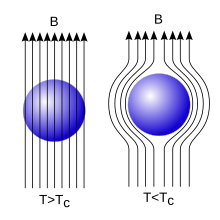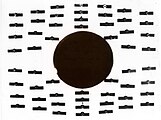Meissner effect: Difference between revisions
I deleted the section "Observation". For explanation of this deletion please refer to "Editing Talk::Meissner effect" by me, Aleitner(Alfred Leitner) for 21 Sept. 2009.. |
Diamonddavej (talk | contribs) Added Meissner and Ochsenfeld (1933) |
||
| Line 1: | Line 1: | ||
[[Image:EfektMeisnera.svg|thumb|right|Diagram of the Meissner effect. Magnetic field lines, represented as arrows, are excluded from a superconductor when it is below its critical temperature.]] |
[[Image:EfektMeisnera.svg|thumb|right|Diagram of the Meissner effect. Magnetic field lines, represented as arrows, are excluded from a superconductor when it is below its critical temperature.]] |
||
The '''Meissner effect''' (also known as the '''Meissner-Ochsenfeld effect''') is the expulsion of a [[magnetic field]] from a [[superconductor]]. [[Walther Meissner]] and [[Robert Ochsenfeld]] discovered the phenomenon in 1933 by measuring the magnetic field distribution outside tin and lead samples. |
The '''Meissner effect''' (also known as the '''Meissner-Ochsenfeld effect''') is the expulsion of a [[magnetic field]] from a [[superconductor]]. [[Walther Meissner]] and [[Robert Ochsenfeld]] discovered the phenomenon in 1933 by measuring the magnetic field distribution outside superconducting tin and lead samples.<ref name=meissner1>{{Cite journal |
||
| volume = 21 |
|||
| issue = 44 |
|||
| pages = 787–788 |
|||
| last = Meissner |
|||
| first = W. |
|||
| coauthors = R. Ochsenfeld |
|||
| title = Ein neuer effekt bei eintritt der supraleitfähigkeit |
|||
| journal = Naturwissenschaften |
|||
| date = 1933 |
|||
| url = http://www.springerlink.com/content/l69w054091n24j14/?p=d517b9e40b344f9bb3fc19ee23a823b3&pi=4 |
|||
}}</ref> The samples, in the presence of an applied magnetic field, were cooled below what is called their superconducting transition temperature. Below the transition temperature the samples cancelled all magnetic field inside, which means they became perfectly [[diamagnetic]]. They detected this effect only indirectly; because the magnetic flux is conserved by a superconductor, when the interior field decreased the exterior field increased. The experiment demonstrated for the first time that superconductors were more than just perfect conductors and provided a uniquely defining property of the superconducting state. |
|||
==Explanation== |
==Explanation== |
||
| Line 34: | Line 45: | ||
==References== |
==References== |
||
{{reflist}} |
|||
*M. Tinkham, “Introduction to Superconductivity”, 2nd Ed., Dover Books on Physics (2004). ISBN 0-486-43503-2 (Paperback). A good technical reference. |
*M. Tinkham, “Introduction to Superconductivity”, 2nd Ed., Dover Books on Physics (2004). ISBN 0-486-43503-2 (Paperback). A good technical reference. |
||
*Fritz London, "Superfluids", Volume I, "Macroscopic Theory of Superconductivity", (1950). Reprinted by Dover. ISBN 0-486-600440. By the man who explained the Meissner effect. pp.34-37 gives a technical discussion of the Meissner effect for a superconducting sphere. |
*Fritz London, "Superfluids", Volume I, "Macroscopic Theory of Superconductivity", (1950). Reprinted by Dover. ISBN 0-486-600440. By the man who explained the Meissner effect. pp.34-37 gives a technical discussion of the Meissner effect for a superconducting sphere. |
||
*Wayne M. Saslow, "Electricity, Magnetism, and Light", Academic (2002). ISBN 0-12-619455-6. pp.486-489 gives a simple mathematical discussion of the surface currents responsible for the Meissner effect, in the case of a long magnet levitated above a superconducting plane. |
*Wayne M. Saslow, "Electricity, Magnetism, and Light", Academic (2002). ISBN 0-12-619455-6. pp.486-489 gives a simple mathematical discussion of the surface currents responsible for the Meissner effect, in the case of a long magnet levitated above a superconducting plane. |
||
*W. Meissner and R. Ochsenfeld, Naturwissenschaften 21, 787 (1933) |
|||
==External links== |
==External links== |
||
Revision as of 19:27, 21 September 2009

The Meissner effect (also known as the Meissner-Ochsenfeld effect) is the expulsion of a magnetic field from a superconductor. Walther Meissner and Robert Ochsenfeld discovered the phenomenon in 1933 by measuring the magnetic field distribution outside superconducting tin and lead samples.[1] The samples, in the presence of an applied magnetic field, were cooled below what is called their superconducting transition temperature. Below the transition temperature the samples cancelled all magnetic field inside, which means they became perfectly diamagnetic. They detected this effect only indirectly; because the magnetic flux is conserved by a superconductor, when the interior field decreased the exterior field increased. The experiment demonstrated for the first time that superconductors were more than just perfect conductors and provided a uniquely defining property of the superconducting state.
Explanation


In a weak applied field, a superconductor "expels" all magnetic flux. It does this by setting up electric currents near its surface. It is the magnetic field of these surface currents that cancels out the applied magnetic field within the bulk of the superconductor. However, near the surface, within a distance called the London penetration depth, the magnetic field is not completely cancelled; this region also contains the electric currents whose field cancels the applied magnetic field within the bulk. Each superconducting material has its own characteristic penetration depth. Because the field expulsion, or cancellation, does not change with time, the currents producing this effect (called persistent currents) do not decay with time. Therefore the conductivity can be thought of as infinite: a superconductor. Note that field expulsion (or cancellation) implies infinite conductivity, but that infinite conductivity does not imply field expulsion, because if a material develops only infinite conductivity below its transition temperature, that infinite conductivity will "freeze in" whatever magnetic field was present as the transition temperature was reached. The theory for field expulsion was given in the London equations by the brothers Fritz and Heinz London.
Perfect diamagnetism
Superconductors in the Meissner state exhibit perfect diamagnetism, or superdiamagnetism, meaning that the total magnetic field B=0 within them. This means that their magnetic susceptibility, = −1. Diamagnetism is defined as the generation of a spontaneous magnetization of a material which directly opposes the direction of an applied field. However, the fundamental origins of the diamagnetism in superconductors and normal materials are very different. In superconductors the diamagnetism arises from the persistent screening currents which flow to oppose the applied field; in normal materials diamagnetism arises as a direct result of an orbital rotation of electrons about the nuclei of an atom induced electromagnetically by the application of an applied field. Very recently, it has been shown theoretically that the Meissner effect may exhibit paramagnetism in some layered superconductors but so far this paramagnetic intrinsic Meissner effect has not been experimentally observed. Mario Rabinowitz and his colleagues showed that a virtual violation of the Meissner effect is possible.
Consequences
The discovery of the Meissner effect led to the phenomenological theory of superconductivity by F. and H. London in 1935. This theory explained resistanceless transport and the Meissner effect, and allowed the first theoretical predictions for superconductivity to be made. However, this theory only explained experimental observations - it did not allow the microscopic origins of the superconducting properties to be identified. Nevertheless, it became a requirement on all microscopic theories to be able to reproduce this effect. This was done successfully by the BCS theory in 1957. It should be noted, however, that the existing theory of the Meissner effect, which includes the phenomenological London's theory, the microscopic BCS one, as well as the classical electrodynamics, is evidently far from completion. The problem is that the Faraday's law is not valid in stationary conditions of the Meissner effect, whereas the existing theory does not suggest any other electric forces needed to accelerate the electrons until the steady state supercurrent described by the London equation is achieved. Obviously, this acceleration can not be instantaneous for a macroscopic observer, because it would violate the causality principle.
-
A tin cylinder - in a Dewar filled with liquid helium - has been placed between the poles of an electromagnet. The magnetic field is about 80 gauss.
-
T=4.2K, B=80 gauss. Tin is in the normally conducting state. The compass needles indicate that MAGNETIC FLUX PERMEATES THE CYLINDER.
-
The cylinder has been cooled from 4.2K to 1.6K. The current in the electromagnet has been kept constant. However, the tin became superconducting at about 3K. FLUX HAS BEEN EXPELLED FROM THE CYLINDER. (Meissner effect.)
Paradigm for the Higgs mechanism
The Meissner effect of superconductivity serves as an important paradigm for the generation mechanism of a mass M (i.e. a reciprocal range, where h is Planck constant and c is speed of light) for a gauge field. In fact, this analogy is an abelian example for the Higgs mechanism, through which in high-energy physics the masses of the electroweak gauge particles,
W±
and
Z
are generated. The length is identical with "London's penetration depth" in the theory of superconductivity.
See also
References
- ^ Meissner, W. (1933). "Ein neuer effekt bei eintritt der supraleitfähigkeit". Naturwissenschaften. 21 (44): 787–788.
{{cite journal}}: Unknown parameter|coauthors=ignored (|author=suggested) (help)
- M. Tinkham, “Introduction to Superconductivity”, 2nd Ed., Dover Books on Physics (2004). ISBN 0-486-43503-2 (Paperback). A good technical reference.
- Fritz London, "Superfluids", Volume I, "Macroscopic Theory of Superconductivity", (1950). Reprinted by Dover. ISBN 0-486-600440. By the man who explained the Meissner effect. pp.34-37 gives a technical discussion of the Meissner effect for a superconducting sphere.
- Wayne M. Saslow, "Electricity, Magnetism, and Light", Academic (2002). ISBN 0-12-619455-6. pp.486-489 gives a simple mathematical discussion of the surface currents responsible for the Meissner effect, in the case of a long magnet levitated above a superconducting plane.
External links
- Maglev Trains Audio slideshow from the National High Magnetic Field Laboratory discusses magnetic levitation, the Meissner Effect, magnetic flux trapping and superconductivity
- Meissner Effect (Hyperphysics)
- YouTube Video Meissner Effect
- Video about Type I Superconductors: R=0/transition temperatures/B is a state variable/Meissner effect/Energy gap(Giaever)/BCS model.






